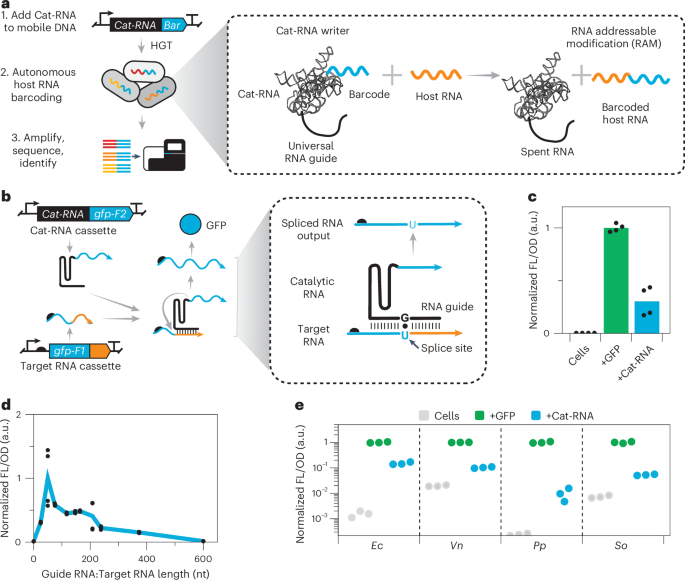Now Reading: Microbial Communities Achieve Data Storage with RNA Barcoding
-
01
Microbial Communities Achieve Data Storage with RNA Barcoding
Microbial Communities Achieve Data Storage with RNA Barcoding

Swift summary:
- The article focuses on advancements in microbiological research, particularly horizontal gene transfer (HGT) and its implications.
- Highlights include studies on bacterial innovation (Ochman et al., 2000), bacterial warfare mechanisms (Granato et al., 2019), and ecological impacts of HGT (Soucy et al., 2015).
- Recent innovations explore synthetic biology,genetic stability in microbiota,programmable protein delivery systems,and antibiotic-driven conjugation dynamics.
- Research underlines the role of mobile genetic elements like plasmids in transferring genes across species boundaries-including bacteria to yeast.
Indian Opinion Analysis:
India’s growing emphasis on biotechnology offers relevant opportunities to leverage insights from these studies for addressing indigenous challenges such as food security, antimicrobial resistance, or healthcare innovation. For instance, scalable applications in agriculture could benefit from engineered microbial systems that optimize crop yield or combat pests sustainably using programmable gene delivery methods.India’s robust scientific infrastructure ensures the ability to build partnerships that translate such global discoveries into localized solutions effectively across sectors.
Read More: LinkQuick Summary
- The raw text lists detailed reference links and studies focused on aspects of microbiology, particularly antibiotic resistance, gene transfer dynamics, bacteriophage engineering, microbial ecology, and environmental influences on bacterial evolution.
- Articles primarily explore horizontal gene transfer mechanisms in relation to the emergence of antibiotic resistance and how synthetic biology or engineered interventions might tackle them.
- Research spans molecular studies of plasmid mobility in pathogenic Escherichia coli to examining microbial gene networks within broader ecosystems.
Indian Opinion Analysis
The research points outlined emphasize critical scientific progress areas essential for public health systems worldwide.For India, where antibiotic resistance is increasingly reported due to overuse or misuse of antibiotics in both human healthcare and agriculture sectors, such advances represent a valuable avenue for addressing future challenges. With India’s expanding biotechnology sector combined with diverse natural microbiomes across urban regions and rural agricultural zones, collaboration on these topics could drive meaningful innovation here. Both policymakers and industry stakeholders might need to prioritize funding toward applying findings in practical frameworks benefiting Indian populations while ensuring responsible use aligned with global standards.
Read moreQuick Summary
- The article explores horizontal gene transfer (HGT) within microbial communities, emphasizing its impact on microbial evolution and genome adaptation.
- Specific studies cited include investigations into the mammalian gut microbiome, plant grafts, bacterial editing techniques, and visualization methods for HGT.
- Emerging technologies like Hi-C sequencing and split ribozymes are highlighted for their role in tracking microbial evolution and detecting native RNA-protein interactions.
Indian Opinion Analysis
The concept of HGT provides insight into understanding how microorganisms evolve and adapt across ecosystems, including agriculture and human health settings in India. Research linking specific genes to functions through innovative methods could advance precision medicine or sustainable farming practices-critical areas for India’s population health needs. Though, ethical oversight is essential when employing these technologies to minimize risks such as unintended genetic consequences or ecological imbalance.
Read more hereIt truly seems the provided text contains a list of scientific references and lacks specific news content related to India. If you could clarify or share the intended raw news article, I’ll be happy to craft the “Quick Summary” and “Indian Opinion Analysis” sections based on accurate information from that text!Quick Summary:
- The raw text describes advancements in various fields of molecular biology, microbiology, and genetics through academic references.
- topics include CRISPR-Cas systems for recording cellular events, analysis of gut microbiota functions using noninvasive methods, and innovations in programmable gene expression across species.
- Key references discuss tools such as transcriptional recording sentinel cells, permanent genetic memory devices, and ultra-high-throughput microbial community analysis platforms like Illumina HiSeq and MiSeq.
Indian Opinion Analysis:
India has been investing heavily in biotechnology innovation under initiatives like “Startup india” and “Make in India,” particularly fostering research ecosystems that might benefit from these international advancements. Tools discussed herein-such as CRISPR-based biological data storage-are instrumental for genomic studies while holding promise for applications in agriculture or healthcare. For instance, noninvasive gut assessments could aid India’s efforts to reduce malnutrition rates through better understanding intestinal health at scale.
These developments highlight the pressing need for Indian universities to form collaborations with global research institutions on projects involving genomics and bioinformatics while reinforcing skills training to translate such science into actionable innovations domestically.
Read more: Source LinkQuick Summary
- The provided material contains various references to scientific articles and studies primarily focused on molecular biology, genetic modification techniques, bacterial growth analysis, and DNA assembly methods.
- Key themes include advancements in gene expression, experimental tools for tracing and recording lineage in cells, cloning methodologies with high throughput capabilities, and dynamic regression analysis for quantitative assessment of microbiological data.
- Several specific studies mention the use of technologies such as Primer3Plus for designing primers or tools developed by EMBL-EBI for search and sequence analysis.
- Horizontal gene transfer’s role in molecular evolution is noted alongside its request within restriction-modification systems.
Indian Opinion Analysis
The references underline the contributions of global research toward enabling more precise biological experiments which could hold implications for India-spanning biotechnology industries to healthcare innovations. India’s growing genetic engineering space might benefit from adopting some of these advanced methods to improve agricultural yields or medical treatments while ensuring ecosystem balance. Focus on computational tools like Python-based bacterial growth assessments can also bolster India’s current trajectory in bioinformatics development-a critical subset given rapid digitalization across sectors.
Read more here on corresponding facets Google Scholar.Quick Summary
- The raw text is a collection of metadata and references from scientific articles in domains such as microbiology, bioinformatics, and computational biology.
- Articles cover topics ranging from analysis tools (e.g., Biopython), sequence analyses (e.g., QIIME 2 for microbiome studies), genomic methods (DADA2), RNA-seq compositional analysis, phylogenetic placement techniques, and nucleic acid system design tools.
- Key journals featured include “Nucleic Acids Research,” “Nature Biotechnology,” “Microbiome,” and more. Tools mentioned include Cutadapt, RESCRIPt, Scikit-learn machine learning library.
- Many of the works referenced are pivotal in advancing fields like microbial taxonomy classification systems.
Indian Opinion Analysis
Even though this article primarily presents international research references rather than India-specific news content or applications directly affecting the country’s policy or scientific industry advancement-it highlights areas ripe for Indian participation. As bioinformatics evolves globally with contributions like QIIME 2 or DADA2 tools for microbial genomics-India could actively integrate these methodologies into national health diagnostics programs or agricultural genomic studies. Strengthening homegrown expertise alongside global collaboration could elevate India’s capacity to innovate in microbiome sciences.
For further details on individual publications: Read MoreQuick Summary
- The raw input provided includes technical references and links, but no specific news article content related to India is included.
- A link to a scientific article on “Nature” titled “s41587-025-02593-0” appears, without contextual information connecting it to india or any relevant analysis.
Indian Opinion Analysis
The absence of clear, context-driven news data or statements in the provided text makes it challenging to assess its meaning for India. For an effective analysis, factual evidence linking the scientific reference or broader implications for Indian society, science community developments, or governmental policy woudl be essential. This highlights the importance of structured inputs when extracting meaningful insights on complex topics.

























